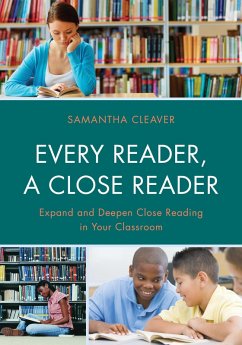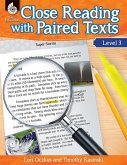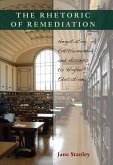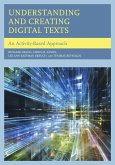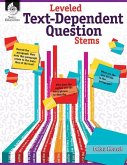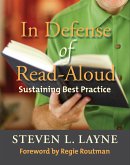Samantha Cleaver
Every Reader a Close Reader (eBook, PDF)
Expand and Deepen Close Reading in Your Classroom
31,95 €
31,95 €
inkl. MwSt.
Sofort per Download lieferbar

16 °P sammeln
31,95 €
Als Download kaufen

31,95 €
inkl. MwSt.
Sofort per Download lieferbar

16 °P sammeln
Jetzt verschenken
Alle Infos zum eBook verschenken
31,95 €
inkl. MwSt.
Sofort per Download lieferbar
Alle Infos zum eBook verschenken

16 °P sammeln
Samantha Cleaver
Every Reader a Close Reader (eBook, PDF)
Expand and Deepen Close Reading in Your Classroom
- Format: PDF
- Merkliste
- Auf die Merkliste
- Bewerten Bewerten
- Teilen
- Produkt teilen
- Produkterinnerung
- Produkterinnerung

Bitte loggen Sie sich zunächst in Ihr Kundenkonto ein oder registrieren Sie sich bei
bücher.de, um das eBook-Abo tolino select nutzen zu können.
Hier können Sie sich einloggen
Hier können Sie sich einloggen
Sie sind bereits eingeloggt. Klicken Sie auf 2. tolino select Abo, um fortzufahren.

Bitte loggen Sie sich zunächst in Ihr Kundenkonto ein oder registrieren Sie sich bei bücher.de, um das eBook-Abo tolino select nutzen zu können.
Close reading, the purposeful, focused reading and rereading of text, is more than an education buzzword. Every Reader, a Close Reader defines and unpacks the components of close reading and explores how to apply it within the context of the Common Core State Standards so that every student will be able to implement close reading strategies in class and independently. Drawing expertise and ideas from research, as well as teachers from across the country, Every Reader, a Close Reader serves as both an instructional guide and professional development tool for classroom teachers and instructional…mehr
- Geräte: PC
- mit Kopierschutz
- eBook Hilfe
- Größe: 6.44MB
Andere Kunden interessierten sich auch für
![Every Reader a Close Reader (eBook, ePUB) Every Reader a Close Reader (eBook, ePUB)]() Samantha CleaverEvery Reader a Close Reader (eBook, ePUB)31,95 €
Samantha CleaverEvery Reader a Close Reader (eBook, ePUB)31,95 €![Close Reading with Paired Texts Level 4 (eBook, PDF) Close Reading with Paired Texts Level 4 (eBook, PDF)]() Lori OczkusClose Reading with Paired Texts Level 4 (eBook, PDF)21,95 €
Lori OczkusClose Reading with Paired Texts Level 4 (eBook, PDF)21,95 €![Close Reading with Paired Texts Level 3 (eBook, PDF) Close Reading with Paired Texts Level 3 (eBook, PDF)]() Lori OczkusClose Reading with Paired Texts Level 3 (eBook, PDF)21,95 €
Lori OczkusClose Reading with Paired Texts Level 3 (eBook, PDF)21,95 €![The Rhetoric of Remediation (eBook, PDF) The Rhetoric of Remediation (eBook, PDF)]() Jane StanleyThe Rhetoric of Remediation (eBook, PDF)36,95 €
Jane StanleyThe Rhetoric of Remediation (eBook, PDF)36,95 €![Understanding and Creating Digital Texts (eBook, PDF) Understanding and Creating Digital Texts (eBook, PDF)]() Richard BeachUnderstanding and Creating Digital Texts (eBook, PDF)47,95 €
Richard BeachUnderstanding and Creating Digital Texts (eBook, PDF)47,95 €![Leveled Text-Dependent Question Stems (eBook, PDF) Leveled Text-Dependent Question Stems (eBook, PDF)]() Debra J. HouselLeveled Text-Dependent Question Stems (eBook, PDF)18,95 €
Debra J. HouselLeveled Text-Dependent Question Stems (eBook, PDF)18,95 €![In Defense of Read-Aloud (eBook, PDF) In Defense of Read-Aloud (eBook, PDF)]() Steven LayneIn Defense of Read-Aloud (eBook, PDF)25,95 €
Steven LayneIn Defense of Read-Aloud (eBook, PDF)25,95 €-
-
-
Close reading, the purposeful, focused reading and rereading of text, is more than an education buzzword. Every Reader, a Close Reader defines and unpacks the components of close reading and explores how to apply it within the context of the Common Core State Standards so that every student will be able to implement close reading strategies in class and independently. Drawing expertise and ideas from research, as well as teachers from across the country, Every Reader, a Close Reader serves as both an instructional guide and professional development tool for classroom teachers and instructional leaders to use when starting or strengthening close reading at the classroom level. In addition, this book includes chapters that focus on developing the close reading skills of students who are struggling readers, English language learners, or gifted learners.
Produktdetails
- Produktdetails
- Verlag: Bloomsbury eBooks US
- Seitenzahl: 1
- Erscheinungstermin: 17. Juli 2015
- Englisch
- ISBN-13: 9798216223146
- Artikelnr.: 75137265
- Verlag: Bloomsbury eBooks US
- Seitenzahl: 1
- Erscheinungstermin: 17. Juli 2015
- Englisch
- ISBN-13: 9798216223146
- Artikelnr.: 75137265
- Herstellerkennzeichnung Die Herstellerinformationen sind derzeit nicht verfügbar.
Samantha Cleaver, PhD, studied read aloud and developed Active Reading during her work with Read Charlotte, a community-wide initiative to double the number of students reading on grade level by 3rd grade in Mecklenburg County, NC. She holds a doctorate in special education with a focus on literacy interventions from the University of North Carolina at Charlotte.
Contents
Acknowledgments
About the Author
Foreword
Introduction
Close Reading: The Best Reading You Can DoReading Theory: A Brief
HistoryClose Reading and the Middle School ReaderEvery Reader a Close
Reader OverviewIn This BookUsing This BookWeAreTeachers SurveyGetting
Started: Understanding Yourself as a Reader Chapter 1: Close Reading and
the Common Core
Introduction to the Common Core State Standards Key Points Using the Common
Core ELA StandardsClose Reading and the Common CoreKey PointsWhat's
Different? The Shifts in the Common Core Shift 1: Balancing Informational
and Literary Text Shift 1: Implications for Close Reading Shift 2:
Knowledge in the Disciplines Shift 2: Implications for Close Reading Shift
3: The Staircase of ComplexityShift 3: Implications for Close Reading Shift
4: Text-Based Answers Shift 4: Implications for Close Reading Shift 5:
Writing From SourcesShift 5: Implications for Close Reading Shift 6:
Academic Vocabulary Shift 6: Implications for Close Reading Key Points
Writing Close Reading ObjectivesKey PointsNext Step: Getting Ready to Read
Chapter 2: Getting Complex: Selecting and Using Close Reading Texts
Reading Complex Texts: A Gatekeeper SkillKey Points Defining Text
ComplexityQuantitative MeasuresQualitative Measures Interpretive
Complexity: Reader and Task Considerations Key Points Planning to Use
Complex Texts Selecting Perfect Passages in LiteratureSelecting Perfect
Passages in Informational Text Choosing Multiple Texts Key Points Gaining
Purpose Chapter 3: Setting the Stage: Welcome Students to Text and Set a
Purpose for Reading
The Purpose Behind the Purpose Key Points Welcoming Students to The Text: A
Case for Frontloading Key Points Using Questions to Set a Purpose for
Reading Creating Text-Based Essential Questions Questions StatementsShould
Questions Key Points Purpose Setting to Dig DeepFirst Reading:
Comprehension SeekingSecond Reading: Analyze the Text Third Reading:
Digging Deeper Key Points Making Every Reading Purposeful Chapter 4:
Talking to Text: Enhance Student Comprehension through Text-Dependent
Questions and Annotation
Crafting Text-Dependent Questions Key Points Creating Sequences of TDQs Key
Points Annotation: Talking to TextKey PointsCiting TextQuotations
Paraphrasing Key PointsCiting Evidence from Multiple Texts Key Points Using
Text Evidence Chapter 5: Applying Close Reading: Create Dialogue and Craft
Arguments
Logic, Evidence and Critical Thinking: Defining ArgumentKey Points Crafting
ArgumentLogos, Ethos, and Pathos Key PointsDialogic Discussion Key Points
Facilitating DiscussionSetting Norms for Discussion: Accountable Talk Key
Points Writing ArgumentKey Points Building Student OwnershipChapter 6:
Letting Students Lead: Create Ownership over Close Reading
Transfer of Close Reading Skills Key PointsIdentifying Student Strengths
Key PointsApplying the Gradual Release Model to Close Reading Key Points
Getting Specific: Releasing Various Aspects of Close Reading
Student-Selected Texts Student-Created Questions Independent
AnnotationStudent-Led DiscussionBuilding the Foundation Chapter 7: Leveling
the Field: Empower Struggling Readers with Close Reading
The Common Core and Special EducationProvide Multiple Means of
RepresentationProvide Multiple Means of Action and ExpressionProvide
Multiple Means of Engagement Key Points Understanding Why Students Struggle
with Close Reading Key Points Planning and Leading Close Reading Lessons
for Struggling Readers Working with Complex TextAccessing Complex Text in
the General Education ClassromAccessing Complex Text in the Resource
Classroom Questioning Interacting with Text: Annotation and Citing Text
Evidence Discussion and WritingLeveling the Playing Field Chapter 8: Engage
English Language Learners in Close Reading
English Language Learners and Close Reading in the Common Core Learning
Academic Vocabulary Engaging in Higher Order Thinking Opportunities to
Interact Key Points Strategies to Plan and Lead Close Reading with English
Language Learners Working with TextQuestioning and Citing Text Evidence
Participating in DiscussionArgument WritingClose Reading with ELLs Chapter
9: Raise the Bar: Challenging High-Achieving and Gifted Learners in Close
Reading
Gifted Students, the Common Core, and Close Reading The Common Core and
Gifted Students A Framework for Gifted Students Key Points Planning and
Leading Close Reading for Gifted Learners Working with Complex TextReading
(and Rereading) for Purpose Participating in DiscussionWriting
ArgumentExecutive Functioning Keeping Close Reading a Challenge Chapter 10:
The Ultimate Question: Assessing Close Reading
Developing Effective Formative AssessmentQuestioning Observation Writing
Key Points Using Formative Assessment Information Giving Effective Feedback
Deep FeedbackImpression FeedbackKey Points Summative AssessmentUsing
Rubrics Close Reading and Standardized TestsKey Points A Worthwhile Task
Appendix A: The MDR/WeAreTeachers Close Reading Survey
Planning and Text Selection Setting a Purpose for Reading Annotation and
Working with Text Respondent DemographicsAppendix B: Literature for Close
Reading in Middle School
Works of Literature: NovelsWorks of Literature: Short Stories Works of
Literature: PoetryPicture Books for Middle School ReadersNonfiction:
BooksNonfiction: Articles and Shorter TextsNonfiction: Primary
SourcesAppendix C: Lesson Plans
Lesson Plan 4.1: Declaration of Sentiments Lesson Plan 4.2: Letters between
John and Abigail Adams Lesson Plan 7.1: 6th Mass Extinction Lesson Plan
8.1: Oranges by Gary Soto Appendix D: Additional Tools
Tool 1.1: Common Core Shifts: Self-Assessment Tool 2.1: Planning for Levels
of Complexity in Text Tool 3.1: Survey: Why do Students Read?Tool 4.1:
Annotation Self-Reflection Tool 5.1: Assess Students' Argument Skills Tool
5.2: Dialogic Classroom Rating Scale Tool 5.3: Argument Writing Foldable
Tool 6.1: Assess Student ReadinessTool 6.2: Assess Student Strengths Tool
6.3: Student Discussion Rating Scale Tool 7.1: Struggling Reader Needs
Assessment Tool 8.1: ELL Needs Assessment Tool 9.1: Gifted Student Needs
Assessment Tool 10.1: Format for a Dual Feedback FormReferences
Index
Acknowledgments
About the Author
Foreword
Introduction
Close Reading: The Best Reading You Can DoReading Theory: A Brief
HistoryClose Reading and the Middle School ReaderEvery Reader a Close
Reader OverviewIn This BookUsing This BookWeAreTeachers SurveyGetting
Started: Understanding Yourself as a Reader Chapter 1: Close Reading and
the Common Core
Introduction to the Common Core State Standards Key Points Using the Common
Core ELA StandardsClose Reading and the Common CoreKey PointsWhat's
Different? The Shifts in the Common Core Shift 1: Balancing Informational
and Literary Text Shift 1: Implications for Close Reading Shift 2:
Knowledge in the Disciplines Shift 2: Implications for Close Reading Shift
3: The Staircase of ComplexityShift 3: Implications for Close Reading Shift
4: Text-Based Answers Shift 4: Implications for Close Reading Shift 5:
Writing From SourcesShift 5: Implications for Close Reading Shift 6:
Academic Vocabulary Shift 6: Implications for Close Reading Key Points
Writing Close Reading ObjectivesKey PointsNext Step: Getting Ready to Read
Chapter 2: Getting Complex: Selecting and Using Close Reading Texts
Reading Complex Texts: A Gatekeeper SkillKey Points Defining Text
ComplexityQuantitative MeasuresQualitative Measures Interpretive
Complexity: Reader and Task Considerations Key Points Planning to Use
Complex Texts Selecting Perfect Passages in LiteratureSelecting Perfect
Passages in Informational Text Choosing Multiple Texts Key Points Gaining
Purpose Chapter 3: Setting the Stage: Welcome Students to Text and Set a
Purpose for Reading
The Purpose Behind the Purpose Key Points Welcoming Students to The Text: A
Case for Frontloading Key Points Using Questions to Set a Purpose for
Reading Creating Text-Based Essential Questions Questions StatementsShould
Questions Key Points Purpose Setting to Dig DeepFirst Reading:
Comprehension SeekingSecond Reading: Analyze the Text Third Reading:
Digging Deeper Key Points Making Every Reading Purposeful Chapter 4:
Talking to Text: Enhance Student Comprehension through Text-Dependent
Questions and Annotation
Crafting Text-Dependent Questions Key Points Creating Sequences of TDQs Key
Points Annotation: Talking to TextKey PointsCiting TextQuotations
Paraphrasing Key PointsCiting Evidence from Multiple Texts Key Points Using
Text Evidence Chapter 5: Applying Close Reading: Create Dialogue and Craft
Arguments
Logic, Evidence and Critical Thinking: Defining ArgumentKey Points Crafting
ArgumentLogos, Ethos, and Pathos Key PointsDialogic Discussion Key Points
Facilitating DiscussionSetting Norms for Discussion: Accountable Talk Key
Points Writing ArgumentKey Points Building Student OwnershipChapter 6:
Letting Students Lead: Create Ownership over Close Reading
Transfer of Close Reading Skills Key PointsIdentifying Student Strengths
Key PointsApplying the Gradual Release Model to Close Reading Key Points
Getting Specific: Releasing Various Aspects of Close Reading
Student-Selected Texts Student-Created Questions Independent
AnnotationStudent-Led DiscussionBuilding the Foundation Chapter 7: Leveling
the Field: Empower Struggling Readers with Close Reading
The Common Core and Special EducationProvide Multiple Means of
RepresentationProvide Multiple Means of Action and ExpressionProvide
Multiple Means of Engagement Key Points Understanding Why Students Struggle
with Close Reading Key Points Planning and Leading Close Reading Lessons
for Struggling Readers Working with Complex TextAccessing Complex Text in
the General Education ClassromAccessing Complex Text in the Resource
Classroom Questioning Interacting with Text: Annotation and Citing Text
Evidence Discussion and WritingLeveling the Playing Field Chapter 8: Engage
English Language Learners in Close Reading
English Language Learners and Close Reading in the Common Core Learning
Academic Vocabulary Engaging in Higher Order Thinking Opportunities to
Interact Key Points Strategies to Plan and Lead Close Reading with English
Language Learners Working with TextQuestioning and Citing Text Evidence
Participating in DiscussionArgument WritingClose Reading with ELLs Chapter
9: Raise the Bar: Challenging High-Achieving and Gifted Learners in Close
Reading
Gifted Students, the Common Core, and Close Reading The Common Core and
Gifted Students A Framework for Gifted Students Key Points Planning and
Leading Close Reading for Gifted Learners Working with Complex TextReading
(and Rereading) for Purpose Participating in DiscussionWriting
ArgumentExecutive Functioning Keeping Close Reading a Challenge Chapter 10:
The Ultimate Question: Assessing Close Reading
Developing Effective Formative AssessmentQuestioning Observation Writing
Key Points Using Formative Assessment Information Giving Effective Feedback
Deep FeedbackImpression FeedbackKey Points Summative AssessmentUsing
Rubrics Close Reading and Standardized TestsKey Points A Worthwhile Task
Appendix A: The MDR/WeAreTeachers Close Reading Survey
Planning and Text Selection Setting a Purpose for Reading Annotation and
Working with Text Respondent DemographicsAppendix B: Literature for Close
Reading in Middle School
Works of Literature: NovelsWorks of Literature: Short Stories Works of
Literature: PoetryPicture Books for Middle School ReadersNonfiction:
BooksNonfiction: Articles and Shorter TextsNonfiction: Primary
SourcesAppendix C: Lesson Plans
Lesson Plan 4.1: Declaration of Sentiments Lesson Plan 4.2: Letters between
John and Abigail Adams Lesson Plan 7.1: 6th Mass Extinction Lesson Plan
8.1: Oranges by Gary Soto Appendix D: Additional Tools
Tool 1.1: Common Core Shifts: Self-Assessment Tool 2.1: Planning for Levels
of Complexity in Text Tool 3.1: Survey: Why do Students Read?Tool 4.1:
Annotation Self-Reflection Tool 5.1: Assess Students' Argument Skills Tool
5.2: Dialogic Classroom Rating Scale Tool 5.3: Argument Writing Foldable
Tool 6.1: Assess Student ReadinessTool 6.2: Assess Student Strengths Tool
6.3: Student Discussion Rating Scale Tool 7.1: Struggling Reader Needs
Assessment Tool 8.1: ELL Needs Assessment Tool 9.1: Gifted Student Needs
Assessment Tool 10.1: Format for a Dual Feedback FormReferences
Index
Contents
Acknowledgments
About the Author
Foreword
Introduction
Close Reading: The Best Reading You Can DoReading Theory: A Brief
HistoryClose Reading and the Middle School ReaderEvery Reader a Close
Reader OverviewIn This BookUsing This BookWeAreTeachers SurveyGetting
Started: Understanding Yourself as a Reader Chapter 1: Close Reading and
the Common Core
Introduction to the Common Core State Standards Key Points Using the Common
Core ELA StandardsClose Reading and the Common CoreKey PointsWhat's
Different? The Shifts in the Common Core Shift 1: Balancing Informational
and Literary Text Shift 1: Implications for Close Reading Shift 2:
Knowledge in the Disciplines Shift 2: Implications for Close Reading Shift
3: The Staircase of ComplexityShift 3: Implications for Close Reading Shift
4: Text-Based Answers Shift 4: Implications for Close Reading Shift 5:
Writing From SourcesShift 5: Implications for Close Reading Shift 6:
Academic Vocabulary Shift 6: Implications for Close Reading Key Points
Writing Close Reading ObjectivesKey PointsNext Step: Getting Ready to Read
Chapter 2: Getting Complex: Selecting and Using Close Reading Texts
Reading Complex Texts: A Gatekeeper SkillKey Points Defining Text
ComplexityQuantitative MeasuresQualitative Measures Interpretive
Complexity: Reader and Task Considerations Key Points Planning to Use
Complex Texts Selecting Perfect Passages in LiteratureSelecting Perfect
Passages in Informational Text Choosing Multiple Texts Key Points Gaining
Purpose Chapter 3: Setting the Stage: Welcome Students to Text and Set a
Purpose for Reading
The Purpose Behind the Purpose Key Points Welcoming Students to The Text: A
Case for Frontloading Key Points Using Questions to Set a Purpose for
Reading Creating Text-Based Essential Questions Questions StatementsShould
Questions Key Points Purpose Setting to Dig DeepFirst Reading:
Comprehension SeekingSecond Reading: Analyze the Text Third Reading:
Digging Deeper Key Points Making Every Reading Purposeful Chapter 4:
Talking to Text: Enhance Student Comprehension through Text-Dependent
Questions and Annotation
Crafting Text-Dependent Questions Key Points Creating Sequences of TDQs Key
Points Annotation: Talking to TextKey PointsCiting TextQuotations
Paraphrasing Key PointsCiting Evidence from Multiple Texts Key Points Using
Text Evidence Chapter 5: Applying Close Reading: Create Dialogue and Craft
Arguments
Logic, Evidence and Critical Thinking: Defining ArgumentKey Points Crafting
ArgumentLogos, Ethos, and Pathos Key PointsDialogic Discussion Key Points
Facilitating DiscussionSetting Norms for Discussion: Accountable Talk Key
Points Writing ArgumentKey Points Building Student OwnershipChapter 6:
Letting Students Lead: Create Ownership over Close Reading
Transfer of Close Reading Skills Key PointsIdentifying Student Strengths
Key PointsApplying the Gradual Release Model to Close Reading Key Points
Getting Specific: Releasing Various Aspects of Close Reading
Student-Selected Texts Student-Created Questions Independent
AnnotationStudent-Led DiscussionBuilding the Foundation Chapter 7: Leveling
the Field: Empower Struggling Readers with Close Reading
The Common Core and Special EducationProvide Multiple Means of
RepresentationProvide Multiple Means of Action and ExpressionProvide
Multiple Means of Engagement Key Points Understanding Why Students Struggle
with Close Reading Key Points Planning and Leading Close Reading Lessons
for Struggling Readers Working with Complex TextAccessing Complex Text in
the General Education ClassromAccessing Complex Text in the Resource
Classroom Questioning Interacting with Text: Annotation and Citing Text
Evidence Discussion and WritingLeveling the Playing Field Chapter 8: Engage
English Language Learners in Close Reading
English Language Learners and Close Reading in the Common Core Learning
Academic Vocabulary Engaging in Higher Order Thinking Opportunities to
Interact Key Points Strategies to Plan and Lead Close Reading with English
Language Learners Working with TextQuestioning and Citing Text Evidence
Participating in DiscussionArgument WritingClose Reading with ELLs Chapter
9: Raise the Bar: Challenging High-Achieving and Gifted Learners in Close
Reading
Gifted Students, the Common Core, and Close Reading The Common Core and
Gifted Students A Framework for Gifted Students Key Points Planning and
Leading Close Reading for Gifted Learners Working with Complex TextReading
(and Rereading) for Purpose Participating in DiscussionWriting
ArgumentExecutive Functioning Keeping Close Reading a Challenge Chapter 10:
The Ultimate Question: Assessing Close Reading
Developing Effective Formative AssessmentQuestioning Observation Writing
Key Points Using Formative Assessment Information Giving Effective Feedback
Deep FeedbackImpression FeedbackKey Points Summative AssessmentUsing
Rubrics Close Reading and Standardized TestsKey Points A Worthwhile Task
Appendix A: The MDR/WeAreTeachers Close Reading Survey
Planning and Text Selection Setting a Purpose for Reading Annotation and
Working with Text Respondent DemographicsAppendix B: Literature for Close
Reading in Middle School
Works of Literature: NovelsWorks of Literature: Short Stories Works of
Literature: PoetryPicture Books for Middle School ReadersNonfiction:
BooksNonfiction: Articles and Shorter TextsNonfiction: Primary
SourcesAppendix C: Lesson Plans
Lesson Plan 4.1: Declaration of Sentiments Lesson Plan 4.2: Letters between
John and Abigail Adams Lesson Plan 7.1: 6th Mass Extinction Lesson Plan
8.1: Oranges by Gary Soto Appendix D: Additional Tools
Tool 1.1: Common Core Shifts: Self-Assessment Tool 2.1: Planning for Levels
of Complexity in Text Tool 3.1: Survey: Why do Students Read?Tool 4.1:
Annotation Self-Reflection Tool 5.1: Assess Students' Argument Skills Tool
5.2: Dialogic Classroom Rating Scale Tool 5.3: Argument Writing Foldable
Tool 6.1: Assess Student ReadinessTool 6.2: Assess Student Strengths Tool
6.3: Student Discussion Rating Scale Tool 7.1: Struggling Reader Needs
Assessment Tool 8.1: ELL Needs Assessment Tool 9.1: Gifted Student Needs
Assessment Tool 10.1: Format for a Dual Feedback FormReferences
Index
Acknowledgments
About the Author
Foreword
Introduction
Close Reading: The Best Reading You Can DoReading Theory: A Brief
HistoryClose Reading and the Middle School ReaderEvery Reader a Close
Reader OverviewIn This BookUsing This BookWeAreTeachers SurveyGetting
Started: Understanding Yourself as a Reader Chapter 1: Close Reading and
the Common Core
Introduction to the Common Core State Standards Key Points Using the Common
Core ELA StandardsClose Reading and the Common CoreKey PointsWhat's
Different? The Shifts in the Common Core Shift 1: Balancing Informational
and Literary Text Shift 1: Implications for Close Reading Shift 2:
Knowledge in the Disciplines Shift 2: Implications for Close Reading Shift
3: The Staircase of ComplexityShift 3: Implications for Close Reading Shift
4: Text-Based Answers Shift 4: Implications for Close Reading Shift 5:
Writing From SourcesShift 5: Implications for Close Reading Shift 6:
Academic Vocabulary Shift 6: Implications for Close Reading Key Points
Writing Close Reading ObjectivesKey PointsNext Step: Getting Ready to Read
Chapter 2: Getting Complex: Selecting and Using Close Reading Texts
Reading Complex Texts: A Gatekeeper SkillKey Points Defining Text
ComplexityQuantitative MeasuresQualitative Measures Interpretive
Complexity: Reader and Task Considerations Key Points Planning to Use
Complex Texts Selecting Perfect Passages in LiteratureSelecting Perfect
Passages in Informational Text Choosing Multiple Texts Key Points Gaining
Purpose Chapter 3: Setting the Stage: Welcome Students to Text and Set a
Purpose for Reading
The Purpose Behind the Purpose Key Points Welcoming Students to The Text: A
Case for Frontloading Key Points Using Questions to Set a Purpose for
Reading Creating Text-Based Essential Questions Questions StatementsShould
Questions Key Points Purpose Setting to Dig DeepFirst Reading:
Comprehension SeekingSecond Reading: Analyze the Text Third Reading:
Digging Deeper Key Points Making Every Reading Purposeful Chapter 4:
Talking to Text: Enhance Student Comprehension through Text-Dependent
Questions and Annotation
Crafting Text-Dependent Questions Key Points Creating Sequences of TDQs Key
Points Annotation: Talking to TextKey PointsCiting TextQuotations
Paraphrasing Key PointsCiting Evidence from Multiple Texts Key Points Using
Text Evidence Chapter 5: Applying Close Reading: Create Dialogue and Craft
Arguments
Logic, Evidence and Critical Thinking: Defining ArgumentKey Points Crafting
ArgumentLogos, Ethos, and Pathos Key PointsDialogic Discussion Key Points
Facilitating DiscussionSetting Norms for Discussion: Accountable Talk Key
Points Writing ArgumentKey Points Building Student OwnershipChapter 6:
Letting Students Lead: Create Ownership over Close Reading
Transfer of Close Reading Skills Key PointsIdentifying Student Strengths
Key PointsApplying the Gradual Release Model to Close Reading Key Points
Getting Specific: Releasing Various Aspects of Close Reading
Student-Selected Texts Student-Created Questions Independent
AnnotationStudent-Led DiscussionBuilding the Foundation Chapter 7: Leveling
the Field: Empower Struggling Readers with Close Reading
The Common Core and Special EducationProvide Multiple Means of
RepresentationProvide Multiple Means of Action and ExpressionProvide
Multiple Means of Engagement Key Points Understanding Why Students Struggle
with Close Reading Key Points Planning and Leading Close Reading Lessons
for Struggling Readers Working with Complex TextAccessing Complex Text in
the General Education ClassromAccessing Complex Text in the Resource
Classroom Questioning Interacting with Text: Annotation and Citing Text
Evidence Discussion and WritingLeveling the Playing Field Chapter 8: Engage
English Language Learners in Close Reading
English Language Learners and Close Reading in the Common Core Learning
Academic Vocabulary Engaging in Higher Order Thinking Opportunities to
Interact Key Points Strategies to Plan and Lead Close Reading with English
Language Learners Working with TextQuestioning and Citing Text Evidence
Participating in DiscussionArgument WritingClose Reading with ELLs Chapter
9: Raise the Bar: Challenging High-Achieving and Gifted Learners in Close
Reading
Gifted Students, the Common Core, and Close Reading The Common Core and
Gifted Students A Framework for Gifted Students Key Points Planning and
Leading Close Reading for Gifted Learners Working with Complex TextReading
(and Rereading) for Purpose Participating in DiscussionWriting
ArgumentExecutive Functioning Keeping Close Reading a Challenge Chapter 10:
The Ultimate Question: Assessing Close Reading
Developing Effective Formative AssessmentQuestioning Observation Writing
Key Points Using Formative Assessment Information Giving Effective Feedback
Deep FeedbackImpression FeedbackKey Points Summative AssessmentUsing
Rubrics Close Reading and Standardized TestsKey Points A Worthwhile Task
Appendix A: The MDR/WeAreTeachers Close Reading Survey
Planning and Text Selection Setting a Purpose for Reading Annotation and
Working with Text Respondent DemographicsAppendix B: Literature for Close
Reading in Middle School
Works of Literature: NovelsWorks of Literature: Short Stories Works of
Literature: PoetryPicture Books for Middle School ReadersNonfiction:
BooksNonfiction: Articles and Shorter TextsNonfiction: Primary
SourcesAppendix C: Lesson Plans
Lesson Plan 4.1: Declaration of Sentiments Lesson Plan 4.2: Letters between
John and Abigail Adams Lesson Plan 7.1: 6th Mass Extinction Lesson Plan
8.1: Oranges by Gary Soto Appendix D: Additional Tools
Tool 1.1: Common Core Shifts: Self-Assessment Tool 2.1: Planning for Levels
of Complexity in Text Tool 3.1: Survey: Why do Students Read?Tool 4.1:
Annotation Self-Reflection Tool 5.1: Assess Students' Argument Skills Tool
5.2: Dialogic Classroom Rating Scale Tool 5.3: Argument Writing Foldable
Tool 6.1: Assess Student ReadinessTool 6.2: Assess Student Strengths Tool
6.3: Student Discussion Rating Scale Tool 7.1: Struggling Reader Needs
Assessment Tool 8.1: ELL Needs Assessment Tool 9.1: Gifted Student Needs
Assessment Tool 10.1: Format for a Dual Feedback FormReferences
Index
